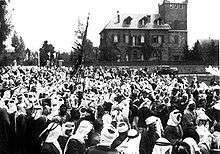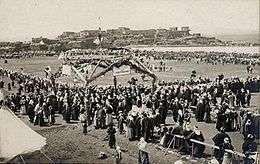Druze in Syria
| Total population | |
|---|---|
| 500,000[1] - 700,000[2] | |
| Languages | |
|
Vernacular: Syrian Arabic | |
| Religion | |
| Druze |
Druze in Syria refers to adherents of the Druze faith, an ethnoreligious[3] esoteric group originating from the Near East who self identify as unitarians (Muwahhideen).[4]
The Syrian Druze people are believed to constitute about 3% of the total population of Syria. The Syrian Druze accounted for an estimated 3 percent of the population (approximately 500 thousand persons).[1] Other sources claim that the Syrian Druze community numbers 700,000.[2] The Druze, who refer to themselves as al-Muwahhideen, or "believers in one God," are concentrated in the rural, mountainous areas east and south of Damascus in the area known officially as Jabal al-Arab or Jabal al-Druze.
History
The Druze faith is a monotheistic Abrahamic religion that does not follow the Five Pillars of Islam, "fasting during the month of Ramadan and making a pilgrimage to Mecca. Thus, they are not regarded by Muslims as Islamic".[5][6] The Druze beliefs incorporate elements of Ismailism, Gnosticism, Neoplatonism and other philosophies. The Druze call themselves Ahl al-Tawhid "People of Unitarianism or Monotheism" or al-Muwaḥḥidūn."
The Druze follow a life style of isolation where no conversion is allowed, neither out of, or into, the religion. When Druze live among people of other religions, they try to blend in, in order to protect their religion and their own safety. They can pray as Muslims, or as Christians, depending on where they are. This system is apparently changing in modern times, where more security has allowed Druze to be more open about their religious belonging."[7]
The Tanukhids inaugurated the Druze community in Syria when most of them accepted and adopted the new message that was being preached in the 11th century, due to their leaderships close ties with then Fatimid ruler Al-Hakim bi-Amr Allah.[8]
The Druze community in Syria played an important role in the formation of the modern state of Syria, and even though they are a minority they play an important role in the Syrian political scene.

In Syria, most Druze live in the Jebel al-Druze, a rugged and mountainous region in the southwest of the country, which is more than 90 percent Druze inhabited; some 120 villages are exclusively so.[9] Other notable communities live in the Harim Mountains, the Damascus suburb of Jaramana, and on the southeast slopes of Mount Hermon. A large Syrian Druze community historically lived in the Golan Heights, but following wars with Israel in 1967 and 1973, many of these Druze fled to other parts of Syria; most of those who remained live in a handful of villages in the disputed zone, while only a few live in the narrow remnant of Quneitra Governorate that is still under effective Syrian control.

The Druze always played a far more important role in Syrian politics than its comparatively small population would suggest. With a community of little more than 100,000 in 1949, or roughly three percent of the Syrian population, the Druze of Syria's southwestern mountains constituted a potent force in Syrian politics and played a leading role in the nationalist struggle against the French. Under the military leadership of Sultan Pasha al-Atrash, the Druze provided much of the military force behind the Syrian Revolution of 1925–27. In 1945, Amir Hasan al-Atrash, the paramount political leader of the Jebel al-Druze, led the Druze military units in a successful revolt against the French, making the Jebel al-Druze the first and only region in Syria to liberate itself from French rule without British assistance. At independence the Druze, made confident by their successes, expected that Damascus would reward them for their many sacrifices on the battlefield. They demanded to keep their autonomous administration and many political privileges accorded them by the French and sought generous economic assistance from the newly independent government.[9]

When a local paper in 1945 reported that President Shukri al-Quwatli (1943–49) had called the Druzes a "dangerous minority", Sultan Pasha al-Atrash flew into a rage and demanded a public retraction. If it were not forthcoming, he announced, the Druzes would indeed become "dangerous" and a force of 4,000 Druze warriors would "occupy the city of Damascus." Quwwatli could not dismiss Sultan Pasha's threat. The military balance of power in Syria was tilted in favor of the Druzes, at least until the military build up during the 1948 War in Palestine. One advisor to the Syrian Defense Department warned in 1946 that the Syrian army was "useless", and that the Druzes could "take Damascus and capture the present leaders in a breeze."[9]
During the four years of Adib Shishakli's rule in Syria (December 1949 to February 1954) (on 25 August 1952: Adib al-Shishakli created the Arab Liberation Movement (ALM), a progressive party with pan-Arabist and socialist views),[10] the Druze community was subjected to a heavy attack by the Syrian government. Shishakli believed that among his many opponents in Syria, the Druzes were the most potentially dangerous, and he was determined to crush them. He frequently proclaimed: "My enemies are like a serpent: the head is the Jebel al-Druze, the stomach Homs, and the tail Aleppo. If I crush the head the serpent will die." Shishakli dispatched 10,000 regular troops to occupy the Jebel al-Druze. Several towns were bombarded with heavy weapons, killing scores of civilians and destroying many houses. According to Druze accounts, Shishakli encouraged neighboring bedouin tribes to plunder the defenseless population and allowed his own troops to run amok.[9]
Shishakli launched a brutal campaign to defame the Druzes for their religion and politics. He accused the entire community of treason, at times claiming they were agents of the British and Hashimites, at others that they were fighting for Israel against the Arabs. He even produced a cache of Israeli weapons allegedly discovered in the Jabal. Even more painful for the Druze community was his publication of "falsified Druze religious texts" and false testimonials ascribed to leading Druze sheikhs designed to stir up sectarian hatred. This propaganda also was broadcast in the Arab world, mainly Egypt. Shishakli was assassinated in Brazil on 27 September 1964 by a Druze seeking revenge for Shishakli's bombardment of the Jebel al-Druze.[9]
He forcibly integrated minorities into the national Syrian social structure; his "Syrianization" of Alawite and Druze territories had to be accomplished in part using violence; he declared: "My enemies are like a serpent. The head is the Jabal Druze, if I crush the head the serpent will die" (Seale 1963:132).[9] To this end, al-Shishakli encouraged the stigmatization of minorities. He saw minority demands as tantamount to treason. His increasingly chauvinistic notions of Arab nationalism were predicated on the denial that "minorities" existed in Syria.[11]
After the Shishakli's military campaign, the Druze community lost a lot of its political influence, but many Druze military officers played an important role when it comes to the Ba'ath government currently ruling Syria.[9]
In 1967, a community of Druze in the Golan Heights came under Israeli control, today about 20,000 strong.
Demographics
Druze |
|---|
 |
|
Important figures |
|
Texts
|
|
Holy places |
|
Holy days |
|
The Druze, who refer to themselves as al-Muwahhideen, or "believers in one God," are concentrated in the rural, mountainous areas east and south of Damascus in the area known officially as Jabal al-Arab or Jabal al-Druze. The Syrian Druze are estimated to constitute 3% of Syria's population of approximately 23 million, which means they amount to between 500,000[1] to 700,000.[2]
Notable people
- Sultan al-Atrash
- Asmahan
- Al-Atrash
- Farid al-Atrash
- Hilal al-Atrash
- Mansur al-Atrash
- Shibli al-Aysami
- Fahd Ballan
- Nawaf Ghazaleh
- Al-Hamdan
- Ziad Hamzeh
- Salim Hatum
- Naji Jaber
- Faisal al-Qassem
- Raja Rafe
- Issam Zahreddine
See also
References
- 1 2 3 "Syria - International Religious Freedom Report 2006". U.S. Department of State. 2006. Retrieved 2009-06-28.
- 1 2 3 "The Economist". 390 (8618–24). 2014: 49. Retrieved 14 April 2011.
- ↑ Chatty, Dawn. Displacement and Dispossession in the Modern Middle East. Cambridge University Press. ISBN 0521817927.
- ↑ Doniger, Wendy. Merriam-Webster's Encyclopedia of World Religions. Merriam-Webster, Inc. ISBN 0877790442.
- ↑ "Druze". druze.org.au. 2015.
- ↑ James Lewis (2002). The Encyclopedia of Cults, Sects, and New Religions. Prometheus Books. Retrieved 13 May 2015.
- ↑ "Druze". druze.org.au. 2015.
- ↑ William Harris (19 Jul 2012). Lebanon: A History, 600-2011 (illustrated ed.). Oxford University Press. p. 46. ISBN 9780195181111.
- 1 2 3 4 5 6 7 Landis, Joshua (1998). Philipp, T; Schäbler, B, eds. "Shishakli and the Druzes: Integration and intransigence". The Syrian Land: Processes of Integration and Fragmentation. Stuttgart: Franz Steiner Verlag. pp. 369–96.
- ↑ Syrian History
- ↑ Jordi Tejel (2008), Syria's Kurds: History, Politics and Society, Taylor & Francis/Google